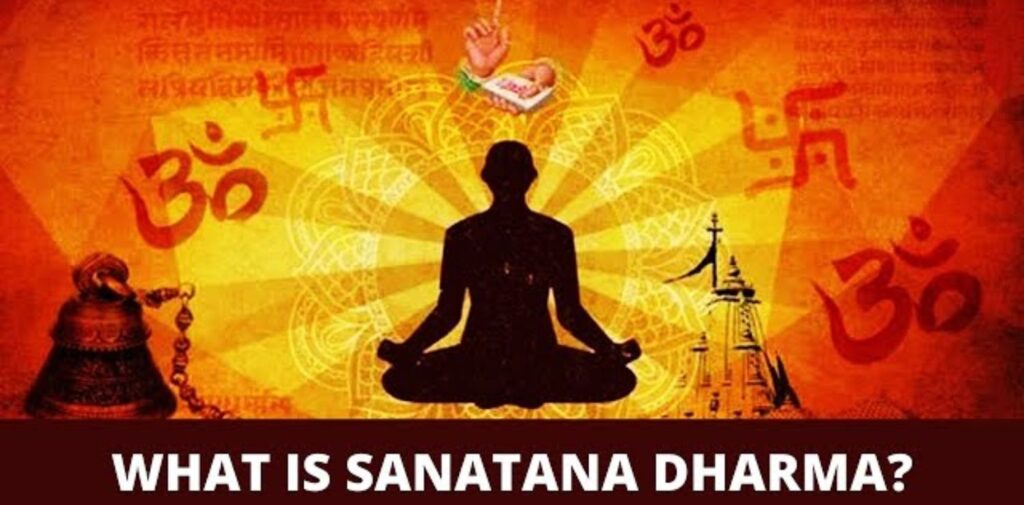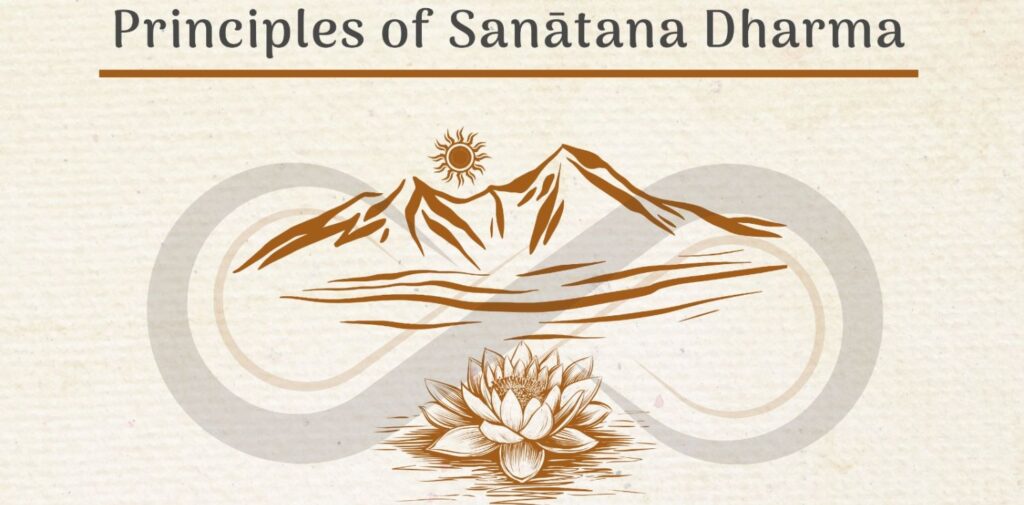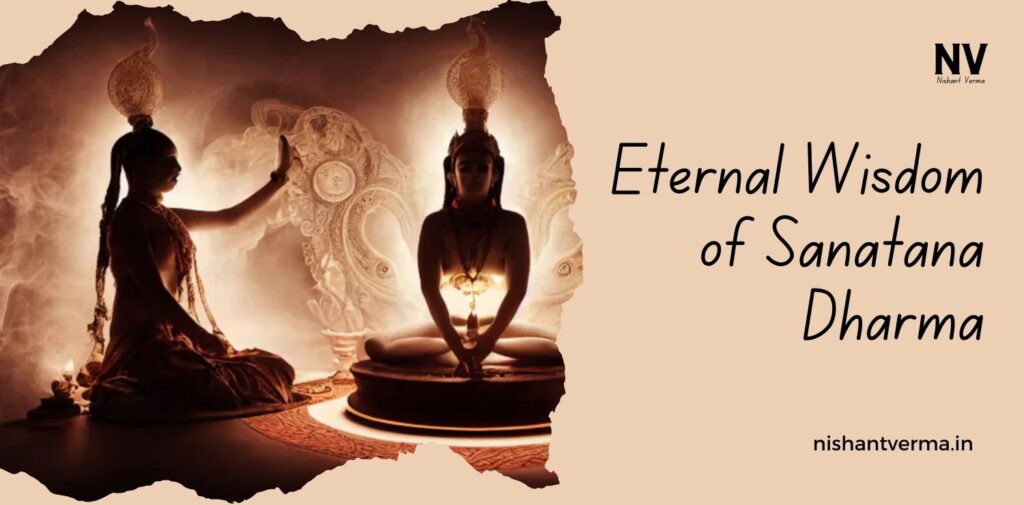Hinduism, one of the oldest and most diverse religions in the world, is deeply rooted in the spiritual and philosophical traditions of India. Known by several names, the most fundamental one is “Sanatana Dharma.” The term “Sanatana Dharma” means the “eternal law” or “eternal order,” which reflects the timeless nature of the wisdom contained in Hindu philosophy. To understand Hinduism and its teachings, it’s essential to explore what Eternal Wisdom of Sanatana Dharma is, its origins, and the values it upholds.
What is Sanatana Dharma?
Sanatana Dharma is a Sanskrit term that can be broken down into two words: Sanatana, which means “eternal” or “everlasting,” and Dharma, which refers to the “cosmic law” or “moral duty.” Therefore, Sanatana Dharma means the “eternal law” that governs the universe and human beings. This law is not just a set of rules or commandments, but a way of life that encourages individuals to live in harmony with the divine, nature, and society.
Unlike other religions that have specific founders, Hinduism, or Sanatana Dharma, is considered to be universal and timeless. It is believed to have been revealed to sages (rishis) in ancient times through spiritual experiences and divine insight. These teachings have been passed down through generations in the form of scriptures, epics, and oral traditions. The wisdom of Sanatana Dharma is not limited to any particular time or place but is considered to be a universal truth, applicable to all humanity.

The Origins of Sanatana Dharma
The roots of Sanatana Dharma trace back thousands of years, making it one of the oldest living religious traditions in the world. Its sacred texts, known as the Vedas, are believed to have been composed around 1500 BCE or earlier. The Vedas, along with other scriptures like The Upanishads, Bhagavad Gita, and Ramayana, form the foundation of Hindu philosophy.
The Vedas are ancient hymns and rituals that were revealed to the rishis, who were deep spiritual seekers. These texts contain knowledge about the nature of the universe, the self, and the divine. They also emphasize the importance of living a life based on truth, righteousness (dharma), and devotion (bhakti).
Over time, the teachings of Sanatana Dharma evolved and expanded, incorporating diverse practices, philosophies, and ideas. This led to the development of various schools of thought within Hinduism, including the paths of yoga, meditation, devotion, and knowledge.

The Core Principles of Sanatana Dharma
While Sanatana Dharma is vast and multifaceted, it is rooted in some key principles that help individuals live in harmony with themselves, others, and the world around them.
- The Concept of Brahman: At the heart of Hindu philosophy is the concept of Brahman, the supreme, formless, and eternal reality. Brahman is the source of all creation, the essence of everything in the universe. It is beyond human comprehension but is present in all things. In Sanatana Dharma, everything is seen as an expression of Brahman, and understanding this unity is the key to spiritual enlightenment.
- Atman (The Self): According to Hindu philosophy, every individual has an eternal soul or Atman. The Atman is not different from Brahman, and understanding this connection is the goal of spiritual practice. The individual soul is often seen as trapped in the cycle of birth, death, and rebirth (samsara), and liberation (moksha) comes when one realizes their true nature as Brahman.
- Karma and Rebirth: The law of karma states that every action has consequences. Good actions lead to positive results, and bad actions lead to suffering. Karma shapes our experiences in this life and future lives. The concept of rebirth, or samsara, teaches that after death, the soul is reborn in a new body. The circumstances of this new life are influenced by the karma accumulated in previous lives. The ultimate goal is to break free from this cycle and attain liberation (moksha), where the soul unites with Brahman.
- Dharma (Righteousness and Duty): Dharma is the moral law that governs both the individual and the universe. It represents truth, righteousness, and the duties that each person has in life. Dharma is not the same for everyone; it varies according to a person’s age, occupation, and life stage. The idea is to live in a way that is aligned with truth, justice, and compassion. By following one’s dharma, a person contributes to the harmony of society and the world.
- The Path of Yoga: Yoga is one of the key practices in Sanatana Dharma. The word “yoga” comes from the Sanskrit word yuj, which means “to unite.” Yoga is a spiritual discipline that helps individuals unite their mind, body, and soul with the divine. There are various types of yoga, including:
- Karma Yoga (the path of selfless action)
- Bhakti Yoga (the path of devotion)
- Jnana Yoga (the path of knowledge)
- Raja Yoga (the path of meditation)
- Importance of Compassion and Ahimsa: Another key principle of Sanatana Dharma is ahimsa or non-violence. Ahimsa is not just about physical harm but extends to thoughts, words, and actions. It emphasizes compassion, kindness, and respect for all living beings. The idea is to live in harmony with nature and all creatures, recognizing that all life is interconnected.
- Role of Scriptures: Sanatana Dharma is based on a vast array of sacred texts that provide guidance and inspiration. The most important of these texts are the Vedas, the Upanishads, the Bhagavad Gita, the Ramayana, and the Mahabharata. The Bhagavad Gita, a part of the Mahabharata, is particularly important for its teachings on duty, righteousness, and devotion. It is a conversation between Lord Krishna and the warrior Arjuna, addressing profound questions about life, morality, and spirituality.

Sanatana Dharma: A Way of Life
What makes Sanatana Dharma unique is that it is not just a religion, but a way of life. It provides a comprehensive framework for living in alignment with the divine order. It encourages individuals to seek spiritual knowledge, live with integrity, and contribute to the well-being of society. It is inclusive, embracing diversity in practices and beliefs. There is no one way to be a Hindu, as the tradition allows for different approaches to spirituality based on individual inclinations and life circumstances.
In Sanatana Dharma, every action, whether it is a small act of kindness or a grand spiritual practice, is an opportunity to align oneself with the divine. The ultimate goal is to live a life of peace, love, and harmony, both within oneself and with others.
Conclusion: Eternal Wisdom of Sanatana Dharma
Sanatana Dharma, or the eternal wisdom of Hinduism, is a timeless tradition that has guided countless people toward spiritual awakening and moral living. It teaches that life is a sacred journey of self-discovery, where the ultimate truth is found in the realization of one’s unity with the divine. Through principles like karma, dharma, yoga, and compassion, Sanatana Dharma offers a holistic approach to life, encouraging individuals to live in harmony with the world around them.
As we continue to explore the depths of this ancient wisdom, it’s clear that Sanatana Dharma offers valuable lessons for people of all cultures and backgrounds. Its message of truth, love, and unity is as relevant today as it was thousands of years ago. Whether you are a follower of Hinduism or someone seeking deeper spiritual understanding, the eternal wisdom of Sanatana Dharma provides a timeless path to inner peace, wisdom, and liberation.




